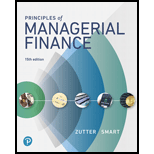
Gitman: Principl Manageri Finance_15 (15th Edition) (What's New in Finance)
15th Edition
ISBN: 9780134476315
Author: Chad J. Zutter, Scott B. Smart
Publisher: PEARSON
expand_more
expand_more
format_list_bulleted
Concept explainers
Question
Chapter 4.3, Problem 4.12RQ
Summary Introduction
To discuss: Bottom lines of cash budget to determine short term borrowing and investment requirements.
Introduction:
Cash budget can be defined as a money spending plan which estimates the money inflows and outflows for a business over a particular timeframe. It is used to assess whether the firm has adequate money to work.
Expert Solution & Answer
Want to see the full answer?
Check out a sample textbook solution
Students have asked these similar questions
Please help with questions
Please help with questions
Help with problems
Chapter 4 Solutions
Gitman: Principl Manageri Finance_15 (15th Edition) (What's New in Finance)
Ch. 4.1 - Prob. 4.1RQCh. 4.1 - Prob. 4.2RQCh. 4.2 - Briefly describe the first four modified...Ch. 4.2 - Describe the overall cash flow through the firm in...Ch. 4.2 - Prob. 4.5RQCh. 4.2 - 4-B Why is depreciation (as well as amortization...Ch. 4.2 - Prob. 4.7RQCh. 4.2 - Prob. 4.8RQCh. 4.2 - Prob. 4.9RQCh. 4.3 - Prob. 4.10RQ
Ch. 4.3 - Prob. 4.11RQCh. 4.3 - Prob. 4.12RQCh. 4.3 - What is the cause of uncertainty in the cash...Ch. 4.4 - Prob. 4.14RQCh. 4.5 - Prob. 4.15RQCh. 4.5 - Prob. 4.16RQCh. 4.6 - Prob. 4.17RQCh. 4.6 - What is the significance of the plug figure,...Ch. 4.7 - Prob. 4.19RQCh. 4.7 - Prob. 4.20RQCh. 4 - Opener-in-Review The chapter opener described a...Ch. 4 - Learning Goals 2, 3 ST4-1 Depreciation and cash...Ch. 4 - Prob. 4.2STPCh. 4 - Prob. 4.3STPCh. 4 - Prob. 4.1WUECh. 4 - Prob. 4.2WUECh. 4 - Learning Goal 3 E4-3 Determine the operating cash...Ch. 4 - Prob. 4.4WUECh. 4 - Learning Goal 5 E4-5 Rimier Corp. forecasts sales...Ch. 4 - Prob. 4.1PCh. 4 - Learning Goal 2 P4-2 Depreciation In early 2019,...Ch. 4 - Prob. 4.3PCh. 4 - Learning Goals 2, 3 P4-4 Depreciation and...Ch. 4 - Learning Goal 3 P4-5 Classifying inflows and...Ch. 4 - Prob. 4.6PCh. 4 - Learning Goal 4 P4-8 Cash receipts A firm has...Ch. 4 - Learning Goal 4 P4-9 Cash disbursements schedule...Ch. 4 - Learning Goal 4 P4-10 Cash budget: Basic Grenoble...Ch. 4 - Prob. 4.11PCh. 4 - Learning Goal 4 P4-12 Cash budget: Advanced The...Ch. 4 - Prob. 4.13PCh. 4 - Prob. 4.14PCh. 4 - Learning Goal 4 P4-15 Multiple cash budgets:...Ch. 4 - Learning Goal 5 P4-16 Pro forma income statement...Ch. 4 - Learning Goal 5 P4-17 Pro forma income statement:...Ch. 4 - Learning Goal 5 P4-18 Pro forma balance sheet:...Ch. 4 - Learning Goal 5 P4-19 Pro forma balance sheet...Ch. 4 - Learning Goal 5 P4-20 Integrative: Pro forma...Ch. 4 - Learning Goal 5 P4-21 Integrative: Pro forma...Ch. 4 - Prob. 4.22PCh. 4 - Prob. 1SE
Knowledge Booster
Learn more about
Need a deep-dive on the concept behind this application? Look no further. Learn more about this topic, finance and related others by exploring similar questions and additional content below.Similar questions
arrow_back_ios
SEE MORE QUESTIONS
arrow_forward_ios
Recommended textbooks for you
- Principles of Accounting Volume 2AccountingISBN:9781947172609Author:OpenStaxPublisher:OpenStax College
 EBK CONTEMPORARY FINANCIAL MANAGEMENTFinanceISBN:9781337514835Author:MOYERPublisher:CENGAGE LEARNING - CONSIGNMENT
EBK CONTEMPORARY FINANCIAL MANAGEMENTFinanceISBN:9781337514835Author:MOYERPublisher:CENGAGE LEARNING - CONSIGNMENT

Principles of Accounting Volume 2
Accounting
ISBN:9781947172609
Author:OpenStax
Publisher:OpenStax College

EBK CONTEMPORARY FINANCIAL MANAGEMENT
Finance
ISBN:9781337514835
Author:MOYER
Publisher:CENGAGE LEARNING - CONSIGNMENT